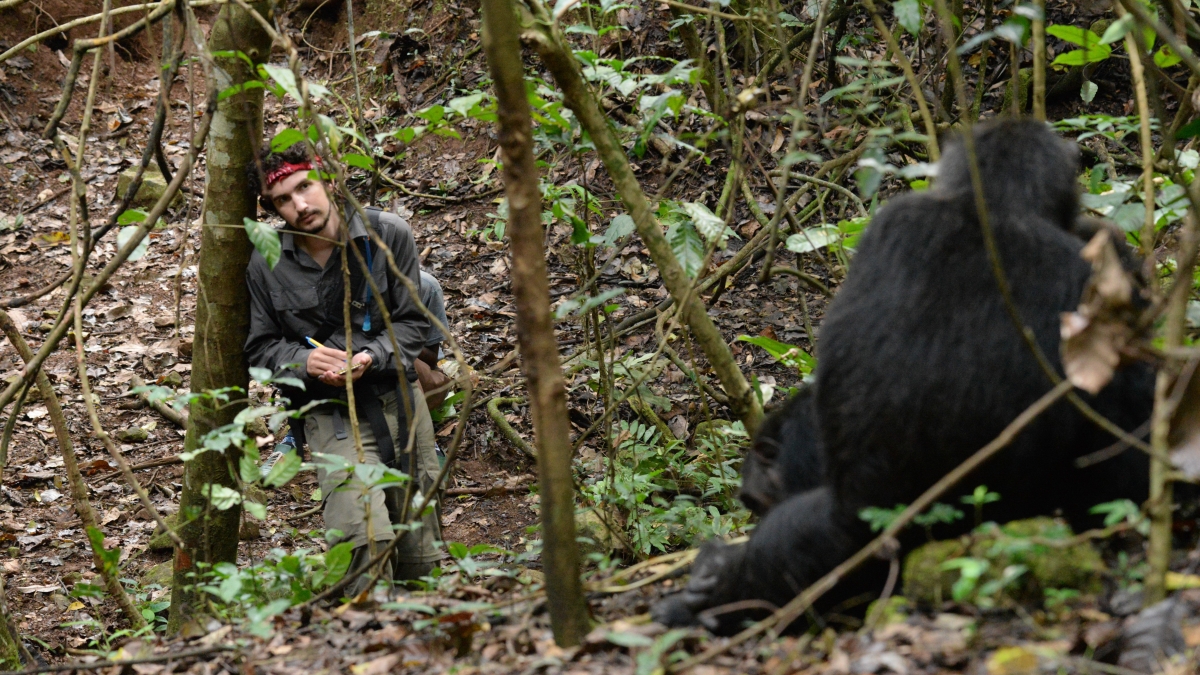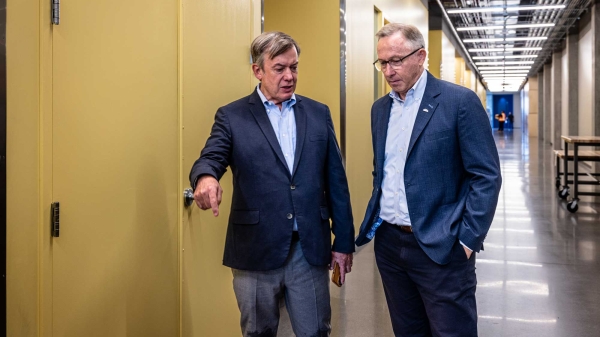Chimp field research unglamorous but worth it for grad student

Joel Bray, a graduate student in evolutionary anthropology at the Institute of Human Origins at Arizona State University, spent the summer observing chimpanzees in Tanzania. It was hard work and often boring — but also at moments amazing, he said.
Photo courtesy Joel Bray
It sounds lovely: spending the summer on the golden slopes high above Lake Tanganyika in Tanzania, watching chimpanzee groups go about their daily lives, working at the world-famous Jane Goodall Institute.
But the reality for one graduate student this past summer was quite different.
Up at 5 a.m., breakfast a boiled egg (if he was lucky), a long hike up steep hills, and then long days noting observations and being bored.
There was also a cobra living in the toilet.
For Joel Bray, research is not a walk in the park
“Whenever I, or others in my position, talk about our work to the public, it sounds really exciting,” Bray, a graduate student in evolutionary anthropology at the School of Human Evolution and Social Change at Arizona State University, wrote on his blog, Primate Dream. “Or when I post photos, it looks incredible. But it’s actually pretty awful. Most of the time we are either sweating out or beyond bored. … Ultimately, though, there is very little that is appealing about what I do, except for the briefest moments when I think to myself, ‘My God, a chimpanzee is literally walking beside me.’ ”
Being patient is an acquired skill, Bray said. When the chimps sit, you sit.
“I think all primatologists have it to some degree, or else we’d never come back to the field a second time, but I’m not sure that I have fully developed it even after several field seasons,” he said. “I am easily bored, and sometimes I have to give everything I have to maintain my sanity while waiting for a chimp to do something. Anything.”
When the chimps move, you move.
“It’s amazing how fast they can traverse thick vegetation,” Bray said, adding that he does not share that skill, especially when they’re cruising up and down steep ravines at top speeds. During those times, he relied on his Tanzanian research assistants, who were very adept at following the chimps. However, “at the end of the day, if they don’t want us around, they can easily do it,” he said.
It was Bray’s first time at the Jane Goodall Institute’s Gombe Stream Research Center. It was his fourth research trip to Africa to study primates, following two trips to Uganda to study chimpanzees and a trip to Madagascar to study lemurs. “I consider myself fortunate,” he said.
On his blog, Bray broadly describes his academic interests as revolving around “what ways primates and humans are both similar to and different from other species, and how we came to be this way.”
“If we want to answer questions about our human origins and evolution, we have to study our nearest living relatives,” he said.
Ian Gilby, assistant professor and faculty member of the School of Human Evolution and Social Change, is his faculty adviser.
“One of the goals of the research group here is to understand what’s different about humans,” said Gilby, who is also a research affiliate of the Institute of Human Origins at ASU.
Bray’s immediate task in Tanzania was to test and implement laser photogrammetry, a method of collecting data on body size using digital photography and lasers. Collecting body-size data on large animals is difficult, for many reasons. This was the first time laser photogrammetry had been used at Gombe, he said.
“Body size is key to lots of things,” Gilby said, noting that the chimpanzees at Gombe are much smaller than the chimps Bray studied in Uganda. Gilby did his PhD at Gombe, finishing in 2004.
“There are guys who are constantly beating up other chimps,” Gilby said. “If you’re a little guy, you might choose a different strategy. If you’re a big guy, beating up everyone all the time might work just fine for you.”
The Gombe chimps have been studied for 55 years now, since Jane Goodall and her mother stepped off a boat onto a beach in 1960. A handful of chimps at Gombe have been followed from birth to death. A 55-year-old female named Sparrow is still there. Bray saw her twice last summer.
“We’re just beginning to get full lifetime follows of chimpanzees,” Bray said. “To follow a single individual takes a long time. … We’re only just beginning to answer those questions.”
The ideal subject for a day of observation is a big group, Bray said, viewed from 26 to 32 feet away.
“Ideally you follow them randomly,” he said. “You don’t want to follow the first ones you see, because they might just be a family that lives near camp.”
Chimps will pass researchers on a trail without a glance. They rarely interact with observers. “If they do, you turn around or walk away,” Bray said.
Baby chimps spend a lot of time looking at researchers. They lose interest over time. “Adults that are fully habituated rarely look at you,” Bray said. “It depends on their comfort level.”
“Different chimp communities behave in different ways,” he said, comparing his Uganda experience to his Tanzania experience. “Having that perspective is really cool. … Having experience at two different sites helps me understand why they’re different.”
He wants to go back, probably for a full year, once he has decided what his dissertation will be.
Another link between ASU and Gombe is Gilby, co-director of the Goodall institute’s long-term database, which is here at ASU. Currently he works with new data generated every day at Gombe.
“It’s a pretty big deal having all the data (from Gombe) here,” Gilby said. “It’s a great opportunity for ASU.”
Field notes from a young primatologist: Excerpts from Primate Dream, Joel Bray’s blog
“We track, follow and observe, hoping to learn the secret to being a successful chimpanzee. In general, the recipe is pretty standard, not much different from any other primate. Find food, defend access to mates, groom others, make friends, raise kids, rinse and repeat. Add a dash of chimpanzee-specific socioecology, and there you have it. Of course the details are ever more complicated and fascinating — and in most cases, yet unknown. Depending on your perspective, that’s either a very wonderful or very unfortunate thing.” — from "Reflections from Paradise," Aug. 1, 2015.
“Did the reality of Gombe meet my expectations? Woody Allen said, ‘The talent for being happy is appreciating and liking what you have, instead of what you don’t have.’ With that in mind, despite the summer’s backdrop of frustrations regarding the lack of food in the forest, and therefore the lack of consistent grouping, I’ve had a lovely and relaxing time alongside some of the most wonderful animals in existence.” — from "Reflections from Paradise," Aug. 1, 2015.
“I find myself reaching a place of serenity in the forest. The sounds of crickets, the chirping of birds, the barks of baboons, even the hissing of the termites. As the forest hums with activity, with the lake stretching out beneath the rolling hills in front of me, I sit back and embrace the solitude. What we lose by letting go we get back in a different currency.” — from "Forest Observations," June 23, 2015.
More Local, national and global affairs

School of Public Affairs surveys thousands of Arizona lawyers, other legal professionals for state bar
When the State Bar of Arizona decided to learn what its members thought about disciplinary procedures, it needed someone to poll…

Arizona’s newest 'college town' says farewell to Mayor John Giles
A few short decades ago Mesa, Arizona, was considered just another quiet little suburb in the Phoenix metro area. Today, the city…

At home and abroad, a fight for freedom and democracy
“If John McCain were here today, he would be on the front lines, standing with our democratic allies and serving as a voice for…